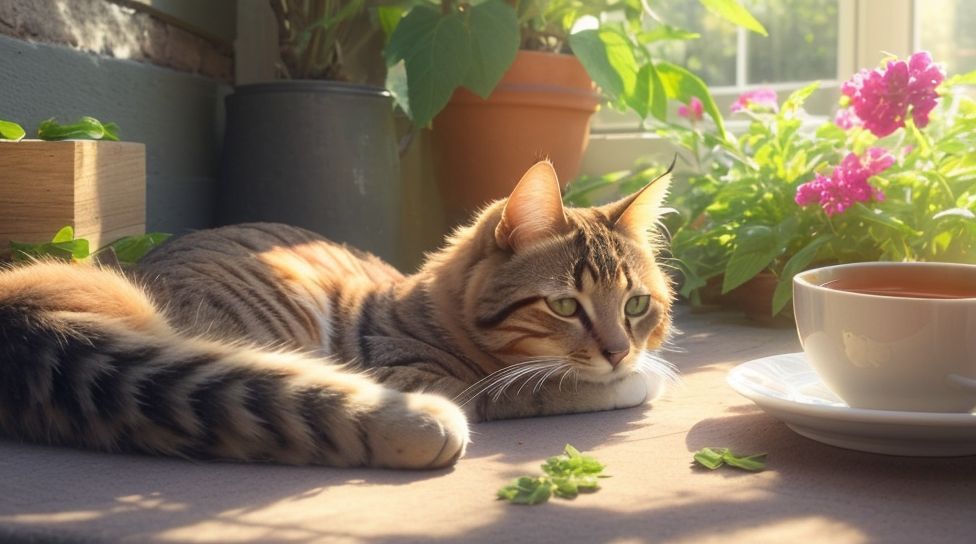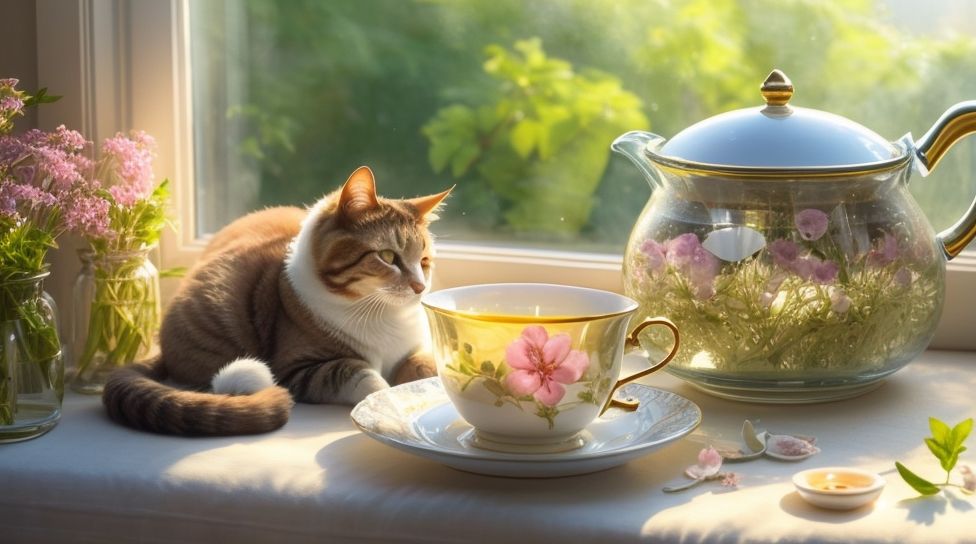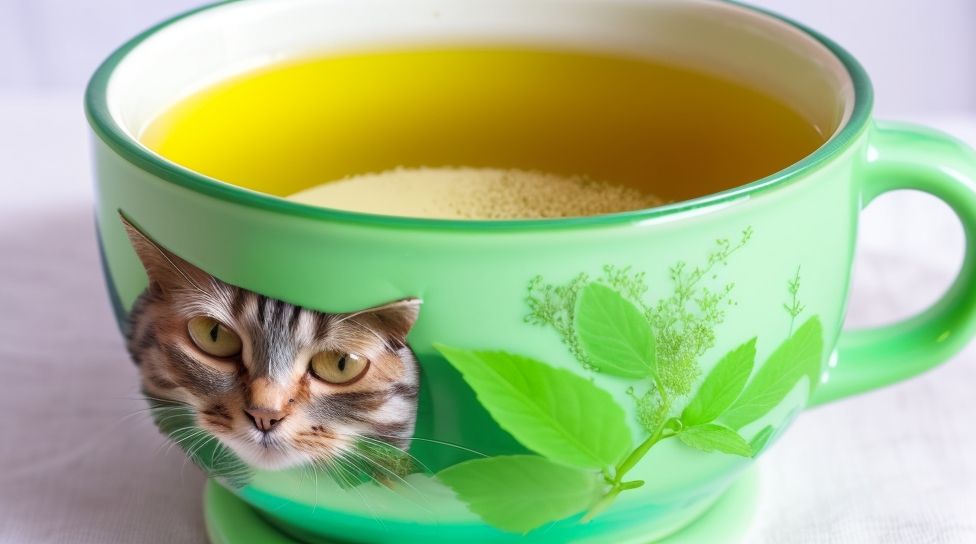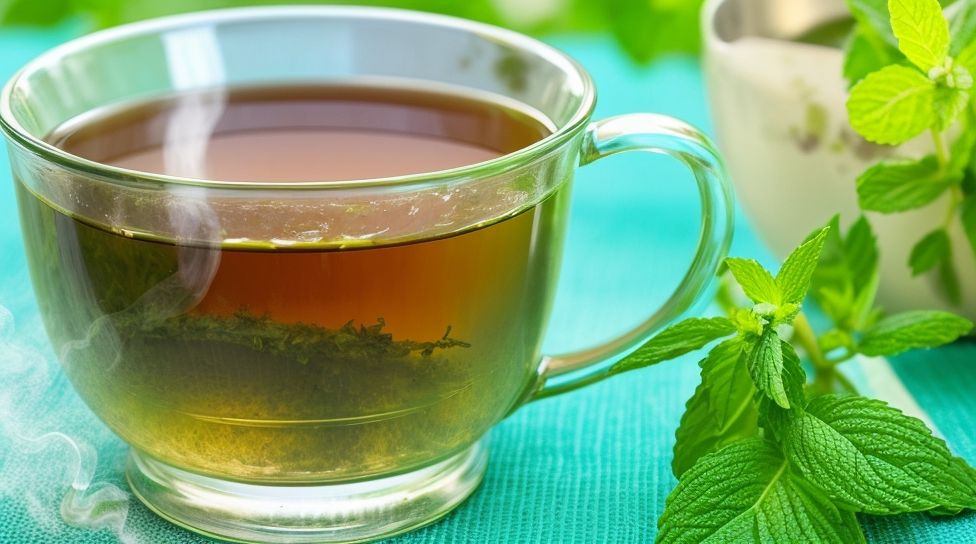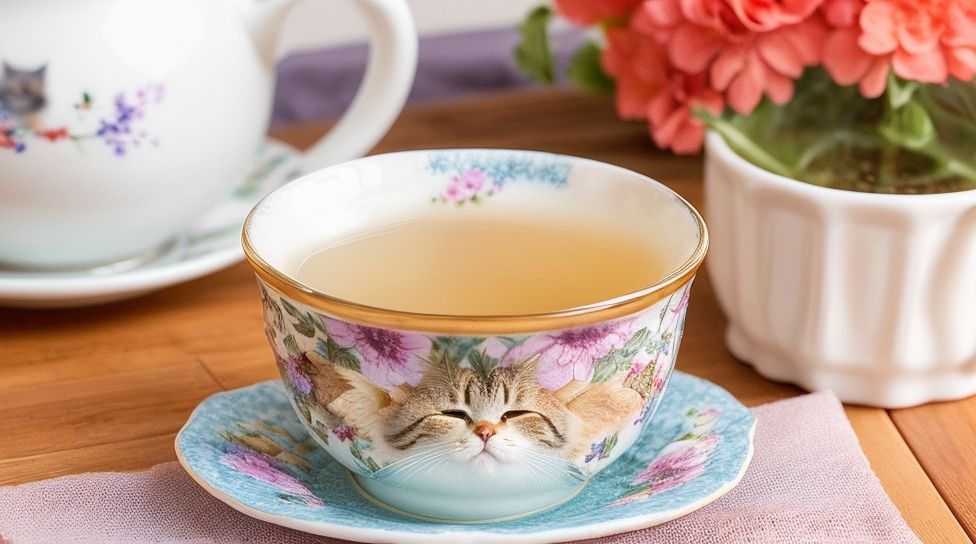
Catnip tea, derived from the leaves of the Catnip plant (Nepeta cataria), is a herbal infusion known for its soothing and therapeutic properties. Catnip contains a compound called nepetalactone, which acts as a natural sedative and relaxation aid. This article provides recipe for making catnip tea, its benefits, and precautions to keep in mind.
Firstly, we will explore what catnip is and how it works. Catnip is a perennial herb belonging to the mint family, known for its highly attractive properties to cats. However, it also has calming effects on humans. Next, we will discuss the benefits and uses of catnip tea. Catnip tea is known to provide stress and anxiety relief, promote digestive health, soothe headaches, and aid in promoting better sleep.
As for making catnip tea, the article will cover the steps involved in gathering the ingredients, preparing the catnip leaves, and brewing the tea. The article will provide tips and variations for making catnip tea, such as adding other herbs or flavors to enhance the taste and adjusting the strength of the tea to suit personal preference.
Lastly, the article will touch upon possible side effects and precautions of consuming catnip tea, as it may interact with certain medications or cause allergic reactions in some individuals. By the end of this article, readers will have a comprehensive understanding of catnip tea, its benefits, and how to make it, enabling them to incorporate this herbal beverage into their wellness routine.
Key takeaway:
- Catnip tea promotes stress and anxiety relief: Catnip tea has calming properties that can help reduce stress and anxiety levels in individuals.
- Catnip tea promotes digestive health: Consuming catnip tea can aid in digestion and soothe digestive discomfort.
- Catnip tea can help soothe headaches: Catnip tea may provide relief from headaches and migraines.
- Catnip tea promotes sleep: Drinking catnip tea before bedtime can help promote relaxation and improve sleep quality.
- Preparing catnip tea: Gather the necessary ingredients, prepare the catnip leaves, and brew the tea according to your preference.
- Variations and tips for catnip tea: Experiment with adding other herbs or flavors to enhance the taste and adjust the strength of the tea to suit your preference.
- Possible side effects and precautions: It is important to be aware of any potential side effects or interactions with medications before consuming catnip tea. Consult with a healthcare professional if needed.
What is Catnip and How Does It Work?
Photo Credits: Www.Teamastershub.Com by Logan Walker
Catnip is a herb that belongs to the mint family. It is known for its effects on cats, but it can also be used to make a soothing and aromatic catnip tea. Understanding what catnip is and how it works is essential before making the tea.
What is Catnip?
Catnip, scientifically known as Nepeta cataria, is a perennial herb native to Europe and Asia. It has heart-shaped leaves and produces small, white or purple flowers. The plant contains a chemical compound called neptalactone, which is responsible for its unique effects.
How Does Catnip Work?
When cats are exposed to catnip, they typically exhibit behaviors such as rolling, rubbing, and purring. This is because the compound neptalactone acts as a stimulant on their sensory systems. It binds to receptors in their nasal tissues, which triggers a response in the brain that leads to behavioral changes.
In humans, catnip has a sedative effect. It can help promote relaxation, relieve stress, and aid in sleep. Catnip tea is a popular way to enjoy these benefits.
Benefits and Uses of Catnip Tea
Photo Credits: Www.Teamastershub.Com by Willie Clark
Looking to explore the wonder and benefits of catnip tea? Look no further! In this section, we’ll uncover the endless possibilities and advantages of incorporating catnip tea into your daily routine. From stress relief and digestive health to soothing headaches and promoting sleep, each sub-section will unveil a different facet of the extraordinary benefits that catnip tea can offer. So get ready to sip your way to wellness with the captivating powers of catnip tea!
1. Stress and Anxiety Relief
When it comes to stress and anxiety relief, catnip tea can be a beneficial option. Here are some reasons why:
- Calming effects: Catnip contains compounds that act as natural sedatives, helping to calm the mind and reduce feelings of stress and anxiety.
- Relaxation: Drinking catnip tea can promote relaxation and help soothe tense muscles, allowing you to unwind and let go of stress.
- Mood enhancement: Catnip tea can boost your mood by increasing the production of feel-good neurotransmitters like serotonin.
- Improved sleep: Stress and anxiety often disrupt sleep patterns. Catnip tea’s relaxation-promoting properties can enhance the quality of your sleep, helping you to wake up feeling refreshed and rejuvenated.
- Reduced nervousness: If you struggle with nervousness or restlessness, catnip tea can help alleviate these symptoms, promoting a sense of calmness and tranquility.
Keep in mind that while catnip tea can be effective for stress and anxiety relief, individual results may vary. It’s important to consult with a healthcare provider if you have any pre-existing medical conditions or if you are taking any medications.
Catnip tea: the purr-fect remedy for feline digestive distress, no fur-ther worries!
2. Promotes Digestive Health
Consuming catnip tea promotes digestive health, offering several benefits.
- One of the benefits of catnip tea is that it relieves indigestion. By soothing the lining of the stomach and reducing inflammation, it helps alleviate indigestion.
- Another advantage is that catnip tea reduces gastrointestinal spasms. Its active compounds possess antispasmodic properties, allowing them to relax and calm the muscles in the digestive tract, which in turn reduces spasms and cramping.
- Catnip tea also aids in digestion. It stimulates the production of digestive enzymes, enhancing the breakdown and absorption of food. Consequently, it promotes more efficient digestion.
- The carminative properties of catnip tea assist in relieving bloating and gas. By promoting the expulsion of trapped gas from the digestive system, it effectively alleviates these discomforts.
- Promoting bowel regularity is yet another benefit of catnip tea. It has gentle laxative effects that prevent constipation and promote regular bowel movements.
- Furthermore, catnip tea reduces nausea. It has a long history of traditional use to soothe an upset stomach and alleviate nausea.
- Supporting liver function is an additional advantage offered by catnip tea. It aids in liver detoxification and promotes healthy liver function, which consequently aids in overall digestion and elimination of toxins.
When enjoying catnip tea for its digestive health benefits, it is important to consume it in moderation and consult with a healthcare professional if you have any underlying health conditions or are taking medications.
Sip catnip tea, because headaches can’t handle the purr-fect relaxation.
3. Soothes Headaches
Here are some ways in which catnip tea can naturally soothe headaches:
- Reduces inflammation: Catnip tea contains natural compounds that have anti-inflammatory properties. These compounds can help decrease inflammation in the muscles and blood vessels of the head, providing relief from headaches.
- Relaxes muscles: Catnip tea possesses muscle-relaxing properties, which can effectively alleviate tension headaches. It aids in the relaxation of the muscles in the head and neck, reducing the intensity of the headache.
- Promotes relaxation: Consuming catnip tea induces a calming effect on both the body and mind. This relaxation can significantly alleviate stress-related headaches and enhance overall well-being.
To enhance the soothing effects of catnip tea for headaches, consider incorporating a teaspoon of dried lavender flowers into the tea. Lavender is well-known for its calming properties and complements the headache-relieving benefits of catnip.
4. Promotes Sleep
- Catnip tea promotes sleep and has been used for centuries as a natural remedy. The active compounds in catnip, such as nepetalactone, have calming and sedative effects on the body.
- Drinking a cup of catnip tea before bedtime promotes relaxation of the mind and body, making it easier to fall asleep and improving sleep quality.
- Catnip tea is especially beneficial for those who suffer from insomnia or have difficulty staying asleep throughout the night, as it promotes sleep.
- The relaxing properties of catnip tea can also help alleviate restlessness and anxiety, allowing for a more peaceful and restorative sleep.
Some suggestions:
- To enhance the sleep-promoting effects of catnip tea, consider steeping it for a longer period of time to extract more of the beneficial compounds.
- Adding a touch of honey or a sprinkle of cinnamon can provide an extra soothing and comforting element to the tea, promoting sleep.
- For optimal results, create a nightly routine by enjoying a cup of catnip tea at the same time each evening before bed, as it promotes sleep.
- It’s important to note that while catnip tea is generally safe for consumption, it may interact with certain medications or have sedative effects. Consult with a healthcare professional before incorporating it into your sleep routine.
Catnip tea: the purrfect elixir for a feline frenzy.
How to Make Catnip Tea
Photo Credits: Www.Teamastershub.Com by Alan Rodriguez
Looking to brew a comforting cup of catnip tea? Look no further. Follow along as we take you through the process of making catnip tea. We’ll cover everything from gathering the freshest ingredients to preparing the catnip leaves, and finally, brewing the tea itself. Get ready to experience the soothing and relaxing effects of this herbal beverage. Let’s dive in and discover the art of making catnip tea!
Gathering the Ingredients
- First, gather fresh catnip leaves or purchase reputable dried catnip leaves.
- Next, find a teapot or a mug to brew the tea.
- You will also need clean, filtered water for brewing the tea.
- If desired, enhance the taste by adding sweeteners like honey or sugar.
It is crucial to ensure the catnip leaves are fresh or properly dried to maintain their potency. Using clean water and a suitable brewing vessel will help in preparing the tea effectively. Adding sweeteners can help balance the herbal taste of catnip tea. Remember not to use excessive amounts of sweeteners to preserve the natural flavor. By following these steps, you can gather all the necessary ingredients to make a delightful cup of catnip tea.
Preparing the Catnip Leaves
To prepare the catnip leaves for making catnip tea, you need to follow these steps:
- Preparing the Catnip Leaves: Harvest fresh catnip leaves from your catnip plant or purchase dried catnip leaves from a trusted source.
- Inspect the leaves and remove any damaged or discolored ones.
- Rinse the leaves under running water to remove any dirt or debris.
- If you are using fresh catnip leaves, pat them dry with a clean towel. If using dried catnip leaves, you can skip this step.
- Once dry, gently crush or bruise the leaves to release their essential oils and enhance the flavor.
- If using fresh catnip leaves, tear them into smaller pieces to make it easier for the flavors to infuse into the tea.
- If using dried catnip leaves, you can leave them as they are or break them into smaller pieces if desired.
- Your catnip leaves are now prepared and ready to be brewed into a delicious cup of catnip tea!
Preparing the catnip leaves is an important step in making catnip tea as it helps unlock the flavors and beneficial compounds present in the leaves. By following these simple steps, you can ensure that your catnip tea is flavorful and enjoyable.
Brewing the Catnip Tea
- To start brewing the catnip tea, boil water in a kettle or saucepan.
- Next, place 1-2 teaspoons of dried catnip leaves in a tea infuser or tea bag.
- Pour the boiling water over the catnip leaves in a cup or teapot.
- Allow the tea to steep for 5-10 minutes to let the flavors infuse.
- Once steeped, remove the tea infuser or tea bag from the cup or teapot.
- If desired, you can sweeten the tea with honey or add a slice of lemon.
- Finally, relish in the soothing experience of drinking your freshly brewed catnip tea!
Pro-tip: To enhance the relaxing effects of the catnip tea, consider adding a few drops of lavender essential oil to the tea before steeping. The combination of catnip and lavender can contribute to an even greater sense of tranquility and calmness.
Tips and Variations for Making Catnip Tea
Photo Credits: Www.Teamastershub.Com by Roger Moore
Thinking of spicing up your catnip tea? Look no further! In this section, we’ll explore some tantalizing tips and variations that will take your catnip tea to new heights. From experimenting with other herbs or flavors to adjusting the strength of the tea, prepare to embark on a flavor adventure that will leave your taste buds feline fine. So grab your teapot and let’s begin the journey into the world of catnip tea experimentation.
Adding Other Herbs or Flavors
When making catnip tea, you have the option to incorporate other herbs or flavors to enhance its flavor and benefits naturally. Here are some suggestions for you to try out:
- 1. Chamomile: By adding chamomile to your catnip tea, you can elevate its calming properties and create a more soothing and relaxing beverage.
- 2. Peppermint: If you mix in peppermint leaves, your catnip tea will have a refreshing and minty twist, which can also aid in digestion.
- 3. Lemon Balm: Combining catnip with lemon balm can enhance the citrusy notes and promote a sense of calm and relaxation.
- 4. Lavender: If you add lavender flowers to your catnip tea, you’ll experience a floral and aromatic infusion that helps promote relaxation and alleviate stress.
- 5. Ginger: Incorporating ginger root can add a spicy warmth to the tea while providing additional digestive benefits.
Remember to start with small amounts of the added herbs and flavors since their intensity can vary. Adjust the proportions according to your taste preferences and desired effects. Enjoy your customized cup of catnip tea with the added goodness of other herbs or flavors!
Fact: For centuries, the combination of catnip and chamomile in tea has been traditionally used to soothe nervousness and promote better sleep.
Can’t handle the heat? Adjust the strength of your catnip tea and take it from purr to meow!
Adjusting the Strength of the Tea
To adjust the strength of the catnip tea, follow these steps:
- Start with the basic catnip tea recipe by adjusting the amount of catnip leaves to your preference. For a stronger tea, increase the amount to 2 teaspoons in 1 cup of hot water. For a milder tea, decrease the amount to 1/2 teaspoon in 1 cup of water.
- If you find the tea too strong or too weak, you can further adjust the strength by adding more hot water or more catnip leaves, depending on your desired taste.
- Remember to let the tea steep for about 5-10 minutes before straining and enjoying.
For those who prefer a stronger herbal effect, it is best to use a larger quantity of catnip leaves. On the other hand, if you’re looking for a more subtle taste, reducing the amount of catnip leaves would be ideal. Adjusting the strength of the catnip tea allows you to tailor the experience to your personal preference. Enjoy experimenting with different variations until you find the perfect balance for your taste buds and well-being.
Possible Side Effects and Precautions
Photo Credits: Www.Teamastershub.Com by Albert Perez
While catnip tea can have various benefits for both humans and cats, it’s important to be aware of the possible side effects and take necessary precautions. Consider the following:
- Allergies: Some individuals may be allergic to catnip. If you have known allergies to other plants in the mint family, such as basil or oregano, it’s advisable to avoid catnip tea.
- Sedation: Catnip is known to have a sedative effect on cats. Similarly, in some individuals, catnip tea may cause drowsiness or relaxation. If you are planning to drive or operate heavy machinery, it’s best to avoid consuming catnip tea.
- Pregnancy and breastfeeding: There is limited research on the effects of catnip tea during pregnancy and breastfeeding. It’s recommended to consult with a healthcare professional before consuming catnip tea if you are pregnant or breastfeeding.
- Interaction with medications: Catnip may interact with certain medications, including sedatives and blood thinners. If you are taking any medications, it’s important to consult with your healthcare provider before consuming catnip tea to avoid any potential interactions.
- Quality and source: Ensure that you are using high-quality, organic catnip leaves for making catnip tea. Avoid using catnip that may have been sprayed with pesticides or other chemicals.
- Proper dosage: It’s important to consume catnip tea in moderation. Start with a small amount and observe how your body reacts before increasing the dosage.
- Avoid giving to infants and young children: Catnip tea is not recommended for infants and young children, as its effects on their developing bodies are not well-studied.
By considering these possible side effects and taking necessary precautions, you can safely enjoy catnip tea and its potential benefits. If you have any concerns or underlying health conditions, it’s always best to consult with a healthcare professional before adding catnip tea to your routine.
Some Facts About How To Make Catnip Tea:
- ✅ Catnip tea can be made with either fresh or dried catnip. (Source: champagne-tastes.com)
- ✅ Catnip is often used as a treat for cats, but it is also edible for humans. (Source: champagne-tastes.com)
- ✅ Catnip tea has been used to treat various health problems such as colicky babies, indigestion, sore throats, headaches, and anxiety. (Source: champagne-tastes.com)
- ✅ Sipping catnip tea can help with relaxation, especially for those who have trouble sleeping. (Source: champagne-tastes.com)
- ✅ To make catnip tea, fresh catnip leaves are rinsed, bruised, and added to hot water. Other herbs like mint can be mixed in for more flavor, along with a little lemon. (Source: champagne-tastes.com)
Frequently Asked Questions
1. How do I make catnip tea using a fillable tea bag?
To make catnip tea using a fillable tea bag, start by placing 1 tbsp of dried catnip in the tea bag. Then, pour 2 cups of boiling water over the catnip-filled tea bag. Let it steep for 3-5 minutes, then remove the tea bag and chill the tea. Serve over ice.
2. Can I use fresh catnip leaves to make catnip tea?
Yes, you can use fresh catnip leaves to make catnip tea. Rinse and bruise the fresh catnip leaves, then add them to hot water. You can also mix in other herbs like mint for more flavor. Let the tea steep for at least ten minutes before enjoying.
3. Are there any known side effects of drinking catnip tea?
While catnip tea is generally safe for both cats and humans, it’s important to note that there haven’t been many scientific studies on catnip. If you are using catnip tea medicinally or if you are pregnant, it’s best to consult with your doctor before consuming catnip tea to ensure there are no potential side effects.
4. Can humans drink catnip tea?
Yes, humans can drink catnip tea. Catnip is not only a treat for cats but also edible for humans. Drinking catnip tea can aid in relaxation, especially for those who have trouble sleeping. Some people also enjoy the minty smell and taste of catnip tea as a refreshing drink.
5. Where can I buy catnip seeds or plants to grow my own catnip?
Catnip seeds or plants can be purchased at local plant nurseries or garden centers. They are usually sold next to other types of mints. Alternatively, you can also buy catnip seeds online and have them delivered to your home. It is recommended to plant catnip in a container to prevent it from becoming invasive.
6. Can catnip tea be used to treat health problems in humans?
Catnip tea has been traditionally used to treat various health problems such as colicky babies, indigestion, sore throats, headaches, and anxiety. However, it’s essential to consult with a doctor before using catnip tea medicinally to ensure its suitability for specific health conditions.
